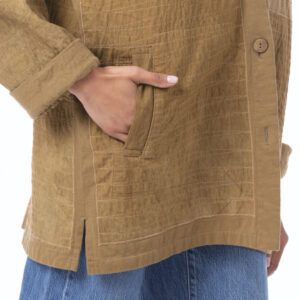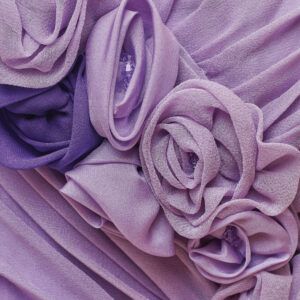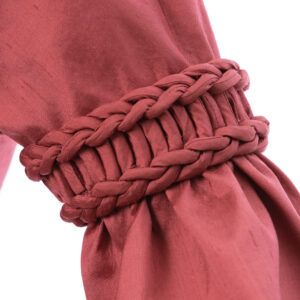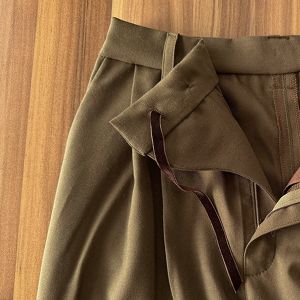I just wanted to share with you all that I washed some silk dupioni and it is lovely . It almost doesnt need ironing as it has a papery feel and add that to the lustre of the fabric,Its really lovely. Has anyone else done this and what did you make out of it?
Conversational Threads
Threads Insider
Get instant access to hundreds of videos, tutorials, projects, and more.
Start Your Free TrialAlready an Insider? Log in
Conversational Threads
Highlights
-
Sign up for the Threads eletter
This site is protected by reCAPTCHA and the Google Privacy Policy and Terms of Service apply.See all newsletters -
 Sponsored Content
Sponsored Content
Where to Buy
-

-

-

-























Replies
I wash nearly every scrap of fabric, no matter the content. I have stopped myself with wool if it's a pre-made garment though!
I made a blouse for my sister-in-law with the silk. It came out very well. She loved it. Happy story.
Meg
Tell us how you washed your silk dupioni! This is very interesting as I pre-wash or steam press everything I sew!
With cold water and shampoo.
I wash dupioni all the time, as I like the finished washed fabric better than the crisp, unwashed version. There is a change in the hand of the fabric that I find much more wearable and more to my liking. There is also a slight loss of the sheen, making the fabric more suitable for casual wear. Also, if you wash dupioni before sewing, you can wash the finished garment.
I use Arm and Hammer detergent, washing machine with cold water wash and rinse, and dry it in the dryer. I do not use fabric softeners or any type of fabric bleach or brighteners. Just the A & H and cold water. For completed garments, I use a gentle cycle and lay it flat to dry (no dryer).
To date, I've had only one problem,and that was with a bright blue. The fabric result had large blotches of dye, rather odd looking. Washing it again, with a "color cathcher" sheet, helped only slightly.
Because of this one problem, I strongly recommend two things: 1. be sure to do a test run with a small piece of the fabric to be sure you like the result and 2. wash the fabric by itself, with no other laundry in the load.
Shannon
Thanks Shannon, I am wondering if the deterrgent you mention is a natural one such as a eucalyptus and soap or one which is more mainstream . I live in Australia and the deterrgent you mention isnt familiar to me .I imagine that a harsher everyday washing powder would be a risk in that it might cause bleaching etc??
You are correct about the detergent. If you can find Orvus quilt wash (it can often be found in farm supply places), I'd recommend using it.
Shannon
You are so right about regular detergent being too harsh. I learnt the hard way! I washed yardage of silk (a silk linen) with regular liquid detergent (Tide) and would not recommend it: the frabric has bleach marks where the detergent landed on the fabric...
I've been wondering what to do with this yardage with spots. The silk dyes in the most recent issue no complicated setting process!) may just be what I need to make it usable!!! (I ordered them. Now just need to find time for my dye experiment.)
Marijke
maybe do some tie dying and embroideryetc it could actually start a highly creative project!
Yes! I've started to think in that direction.
Until earlier this week I had NO experience with tie dye. Just this week, I used rubber bands to tie a leftover yard-or-so of hemp in burgundy and dunked it in a bucket of bleach/water. The result is a lovely tie UNdye pattern in burgundy (original color) and a brighter red where the fabric was exposed to the bleach. After neutralizing the bleach (chlor-stop), I then washed the fabric with Dawn (as recommended for linen in a recent Threads article by Judy Neukam) and the result is a lovely soft fabric with a red/burgundy tie dye pattern.
Tie dye is really easy and so much fun to open it up and see what you got! I think I WILL tye die that silk fabric I messed up and experiment with something creative!
Thanks for the encouragement!
Marijke
where are you as I am inAustralia and I posted that message only a few hors ago and so you must be in my time zone or else an American insomniac!
I recently saw an article about how to fix up bleach spots on Jean which have had household bleach dropped on them..They over dies with another colour in this case a pink and then appliquied flowers over thebad spots in a tone of pink The result was fantastic and a good example of not getting upset but using a distaster as a creative challenge and going place you may not have gone before!
Hi:
Those jeans sound great! As a teen I covered up worn out spots with embroidery and appliqued patches -- kind of got away from that, but now it sounds cool again.
I'm in Missouri/USA. Not sure I qualify as an insomniac -- just checking my e-mail as the kids were brushing their teeth and changing into their pyjamas. :-)
Marijke
thats the mid west isnt it ?Its 2 pm in the afternoon here and i am just killing time waiting for a patient to arrive .
We're really off topic! :-) But, yes, I am in the midwest. About 7-8hours drive south/southwest of Chicago.
It's midnight as I'm writing this. Time to log off and get some sleep (the kids won't sleep in!).
Marijke
Just a couple of cautions when it comes to bleach or chlorine bleach do not use it on any fabric that has even the smalles hint of linen fibers in it as you will have a most unpleasant experience with it. Also I would not recommend bleach with the silk either as I recall reading somewhere I think it will eat the fibers.
Terry:
Can you explain? I just bleached some black linen and I don't spot any adverse effects. If there's something I should know about, please tell me.
(I used soft scrub and after washing that out I used "chlor stop" and then washed the fabric in the washing machine with Dawn dish detergent -- it came out beautifully soft, so I thought it worked out well...)
I do know that one shouldn't bleach silk, it's a protein fiber, like wool. Linen (like cotton and hemp, which I've both bleached as well), is a plant fiber. So I figured: plant fibers react one way, protein fibers another. Am I wrong?
Please advise!
Marijke
maybe the chlor stop did the trick. Why were you bleaching back linen and what colour was it later?
It was an experiment with discharging fabric. This was black linen and it bleached to an off-white with a bit of greyish undertone. It sort of has a look like old photos...
I also discharged some maroon hemp which came out red. The hemp also seems to hold up just fine.
I used chlor-stop with both. When I did small samples, I did not use chlor-stop. I didn't see anything that looked particularly worrisome, which is why I proceeded with the project.
I'm new to discharging and dyeing. Just trying out something new and trying to learn...
Marijke
The main reason not use bleach on linen especially white linen is that the bleach will break down the fibers as well as cause yellowing of the fabric. I was also told that any bleach on natural fibers would break down the fibers the especially if left in contact long enough. I remember growing up and treating pools with chlorine and getting the chlorine on 100% cotton t-shirts winding up with holes where the bleach hit. So I have never brought bleach into the laundry room without diluteing it greatly and never add the fabric until the bleach has been fully diluted and mix throughly. That said it does not mean that you can not or should never use bleach on these fibers but must do so with caution. I was not aware that you were discharge dyeing. But just a word of caution about the effects. As long you are not trying to remove stains and you are using the process as a way of changing the fiber, but to say that in general that using bleach on linen or other natural fibers is generally not a good idea.
Thanks! I think I understand. Bleach does indeed damage fibers, but it's also quite neat to discharge the fabric! I did use it diluted (a little bleach in a bucket of water goes a long way!). I guess to me some damage to fibers can be OK: I was also told that washing linen in the washing machine damaged the fibers... It does break them down. But it also makes linen so much softer and much less prone to wrinkling... So I guess it's a matter of what damage you are willing to live with?
just a little info on linnen.(probably more than you want to know) it comes from the Flax plant, the plants are picked/harvested in some way, then after they are dried, the seeds are removed and a process of RETTING (rotting) occurs, this can be done by chemical means, bacterial or with dew or in stagnant ponds where it can rot. this allows the pectin which is like a glue holding the fibers together in the stems to be removed by decomposition. after this the stems are washed and dried and the woody portion is removed by a process called SCUTCHING - its passed through mettal rollers that break it up and the fibers get seperated. then, they go through a process called HACKLING this combs out the shorter fibers and leaves the nice longr ones combed out - then it goes for spinning and weaving. So, the point I'm making here is that the linned is put through the ringer before you ever get it, It is also resistant to Alkalis, organic solvents and high temperatures, so it can be dry cleaned, machine washed AND bleached with chlorine bleaches without damaging the fibers. Linnen will dye well, but does take more effort than say cotton because the fibers are actually somewhat water resisant.
Judy
Judy:
Thanks for the lesson on linen. I knew it was the flax plant, but did not know the rest of the process. Fascinating! If I understand correctly, it also means it's OK to discharge linen? Within reason, of course (i.e. properly diluted with water).
Do you know similar information about hemp fibers? They seem tougher than linen (dulling the needle faster and hard on scissors, too). I washed the discharged linen and hemp in the washing machine with Dawn dish detergent (per the article by Judy Neukam about washing fabrics to alter texture), and both seem to have become softer as a result.
Again, thanks for the info.
Marijke
hemp is actually sort of a trash plant, its a weed, will grow in most any condition, uses much less water than cotton, is much more bug resistant than cotton,(read - takes less irrigiation/chemicals to grow)- and pulls pollution out of the soil/ground water,(mercury and zinc) it grows faster than cotton and flax and produces 250% more fiber than cotton and 600%more fiber than flax on the same amount of land. hemp was banned from this country not because of its "marjuana" like properties, but because the cotton industry was scared of it taking over the market. The cotton lobbiest made a run on Washington to get it banned using the marjuana excuse as a scare tactic.hemp resembles linnen to the point it is even hard to distiguish it microscopically, but the hemp fibers are a lot longer than linnen, they can be 3 to 15 feet in length. (cotton is at the most 2 1/2 inches long, linnen is a bit longer than that, the longer the fiber the stronger the thread. - oone reason why polyester and silk are stonger, they are one continuous fiber (or fillament) hemp is very resistant to rotting( from dampness), ultraviolet light and mold. and yes, it is stronger than linnen fibers so it will dull the scissors faster.The cotton industry has also banned the naturally colored cottons from the american landscape because they don't want it to contaminate their lilly white cotton plants. naturally colored cotton is really quite beautiful, it comes in greens to reddish browns. There are one or two places in the states that grow it and I'm drawing a blank on the name of one of them (its too late at night to think clearly) BTW, I got most of this information out of my textiles text book "TEXTILES" by Sara Kadolph & Anna Langford - Prentice Hall publishers, its a great book
and, since this thread (pun intended there) started about washing silk dupioni, YES, silk can be washed and won't shrink, when silk is processed off the cocoon, it is treated in a bath of very hot water to disolve the glue holding the cocoon together. Bleach will ruin silk like it does wool, ever get bleach on your hand and it feels sort of slik and slimmy? thats becasue its disolving the protein in your skin, wool and silk are protein fibers.NOw, I would not wash many silks such as silk satin as the washing would damage the more fragile weave of it and on another posting someone asked about washing a silk smoking jacket that she paid $800.00 I wouldn't dream of doing that to an already constructed garment, I would only wash silk as yardage before I cut into it, once washed it will also then resist water spotting (from those rowenta irons) washing silk dupioni will change its hand because it gets rid of the finishes that manufacturesrs put on them, but it comes pretty close to the original when pressed. if you want the shiny crispy look it comes with, don't wash it.
That is really interesting. I made my son a pairof shorts out of hemp years ago (at least 10) and they are still going strong . Apparently denim was originally made of hemp.
Judy I agree and understand about the riggers that Linen goes through before ever becoming fabric. The problem with Bleach or Chlorine with Linen as I stated in my previous posting is the fibers become yellow over time with the use of Bleach or Chlorine. I base this on information that I recieved from the Masters of Linen in New York City and although this may seem like it would only be a problem for white linen that you wish to keep white it will also effect any discharge fabric giving it a yellow cast over time and change the final color of the fabric. Also the reason for the change of hand of the fabric is also a symptom of the further break down of the fibers that you talked about in your posting that is a part of the process. Also as another thought the Masters of Linen also do not recommend spray starch to add the crispness back to linen as the starch will attract bugs that will eat the starch as well as the linen. So I will say that as a process for discharging dye from linen it is a wonderful process and a lot of fun to do, I would not recommend the process for any garment or item that is meant as an heirloom or would be of heirloom quality.
This post is archived.